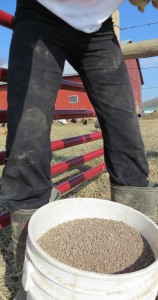Prep your garden for spring planting as soon as the snow has melted and the ground surface is exposed. Doing so allows ample time to test soil and make necessary amendments to improve texture, pH and fertility.
At a glance
A quick look at soil color, texture, microbes and moisture can help guide your improvement efforts.
- Deep, dark and rich colored soil is preferable because it contains higher levels of organic matter than dusty, light colored soil. Dig deeper and you’ll notice changing color due to changing mineral content, more water, less air and less organic matter.
- Sand, silt and clay particles give soil its texture. Sand particles feel large and gritty. Silt feels smooth and smaller and clay feels heavy and compact.
- Microbes and worms. Bacteria, fungus and algae may be too small to see, but they benefit soil by breaking down organic matter. Worms tunnel through soil creating oxygen channels and dispensing nutritious castings.
- Everyone knows the impact too little water has on plants, but too much water smothers roots. Working wet soil causes compaction.
Squeeze a handful of garden soil in the palm of your hand. If it falls apart when you open your fist, the soil is okay to work. If it sticks in a clump, wait a couple of sunny days for soil to dry before working.
Test soil
Some people test soil in fall after harvest is complete and the garden bounty has taken its toll. Others prefer to do it first thing in spring. Either way soil testing offers a valuable baseline reading of nutrient levels, organic matter percent and pH and informs how to prepare your garden soil for spring planting.
Without a soil test you can only guess your garden’s needs. Applying commercial fertilizers blindly may work against you. For example, applying too much nitrate lowers yield. Nutrient runoff may enter ground water and have negative effects. Don’t spend money on unnecessary and potentially hazardous fertilizer amendments; target the area in need with the right amount of fertilizer based on a soil test.
Lime application to increase soil pH, neutralizing soil, is common in my acidic area. Sulfur application to decrease soil pH, making it more acidic, is less common. Most garden plants require a pH between 6.0 and 7.0. The importance of a soil test for pH is evident because there is no way to know your soil’s pH without a test and no way to know if a pH amendment is necessary.
Home soil test kits exist, but I strongly recommend a professional test. A Google search will turn up several soil testing labs in your area. Individual lab websites instruct how to take a sample and where to send your soil. Test results will pinpoint problems and prescribe amendments to prepare your garden soil for a successful season.
Weed control
In spring the sound of tilling tractors and roaring rototillers bounce off the hills surrounding my small farm. It makes me cringe, because I know too much tillage depletes nutrients and damages soil structure.
Trust me, I love that fresh-tilled look as much as you do, but only till when it is absolutely necessary. Consider one of these alternative methods of weed control instead: Dig, hoe or turn weeds under by hand, apply a natural herbicide or smother weeds with newspaper or black plastic.
Ready, set, plant!
After amending your soil according to soil test results and removing weeds, it’s time to plant your spring garden. I can’t wait to smell the fresh spring air and feel the sun-warmed soil beneath my feet again!
Related:
- How to test your garden’s soil Jan. 20, 2015














Ms. Harlow
Very nice article.
Many writers overlook the need of soil tests to point our what elements are needed by the soil and the pH needed for the crops you are growing.
Soil biology is so important and is totally overlooked in many instances.
Need more articles like this.
Jim Loepp
Technical Sales
(407) 340-763
jloepp@organicpro.com